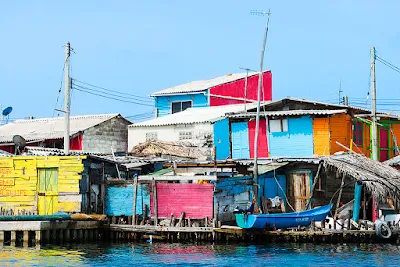Santa Cruz del Islote is an artificial island located off the coast of Bolívar Department in Colombia. It is a part of the Archipelago of San Bernardo. Its significant population compared with its small size results in its being one of the most densely populated islands on Earth.
The islet of artificial origin was started by locals who used materials such as coral, debris or stones to later gain land to the sea in a part of the coast of low tide, it is believed that this first establishment dates from 1870. Due to its small size some locals would later migrate to neighboring islets such as Tintipán or Mucura. In 2013 a community council was formed by the local inhabitants to discuss local problems. In 2018 the island was affected by the flooding caused by the strong tidal wave, and some houses were affected.
The islet of artificial origin was started by locals who used materials such as coral, debris or stones to later gain land to the sea in a part of the coast of low tide, it is believed that this first establishment dates from 1870. Due to its small size some locals would later migrate to neighboring islets such as Tintipán or Mucura. In 2013 a community council was formed by the local inhabitants to discuss local problems. In 2018 the island was affected by the flooding caused by the strong tidal wave, and some houses were affected.
The island has a total area of just above one hectare (12,140.57 m2). It can be accessed by ferry from the port of Tolu. The inhabitants have to use neighboring islands as cemetery and recreation grounds, and they work on the mainland rather than on the island. There is one school, with one teacher. The Mucura Island Hotels are a prime source of work for the residents. In November 2016, with the support of the Universidad del Magdalena and the Universidad de los Andes, a population census was carried out which determined that 485 people inhabited the place.
It has about 493 inhabitants and 65% of the population is under age, there are only 6 surnames and 97 houses. On the island there are some shops, a health post, an educational centre where students can attend up to eleven grades, and currently there are solar cells donated by the Japanese government, which supply the island with energy 24 hours a day. The most spoken language as in the rest of Colombia is Spanish and the majority of the population is Christian, mainly Catholic.
Due to its small size, the territory does not have any kind of autonomy, geographically it is part of the San Bernardo Archipelago in the Department of Bolivar in the north of Colombia, and is occasionally guarded by the Colombian Navy and due to its small size the economic activities are limited to subsistence fishing and the growing tourism attracted by the particularities of the island. It is possible to swim with sharks, rays and fish in a small makeshift pool that functions as an aquarium and to take short walks around the streets of the island. Some notices are in Spanish and English which suggests a recent interest in visiting the place by Colombians and foreigners.
Since there is no space on this one due to overcrowding. Marcela Lizcano, a film director from Bogota, made a documentary called Aislados (Isolated), in which she shows what life on the island is like, its main activities and problems.
It has about 493 inhabitants and 65% of the population is under age, there are only 6 surnames and 97 houses. On the island there are some shops, a health post, an educational centre where students can attend up to eleven grades, and currently there are solar cells donated by the Japanese government, which supply the island with energy 24 hours a day. The most spoken language as in the rest of Colombia is Spanish and the majority of the population is Christian, mainly Catholic.
Due to its small size, the territory does not have any kind of autonomy, geographically it is part of the San Bernardo Archipelago in the Department of Bolivar in the north of Colombia, and is occasionally guarded by the Colombian Navy and due to its small size the economic activities are limited to subsistence fishing and the growing tourism attracted by the particularities of the island. It is possible to swim with sharks, rays and fish in a small makeshift pool that functions as an aquarium and to take short walks around the streets of the island. Some notices are in Spanish and English which suggests a recent interest in visiting the place by Colombians and foreigners.
Since there is no space on this one due to overcrowding. Marcela Lizcano, a film director from Bogota, made a documentary called Aislados (Isolated), in which she shows what life on the island is like, its main activities and problems.













No comments:
Post a Comment
Stay updated with our blog for more quality content! Your feedback is appreciated. Contact us at harshrex@outlook.com with any suggestions.